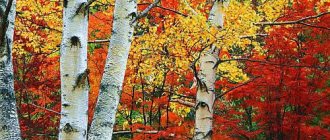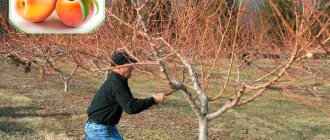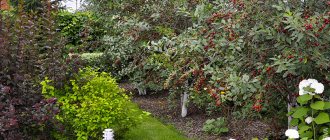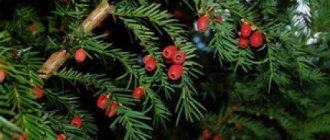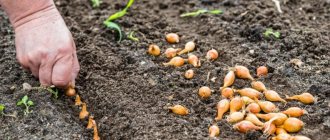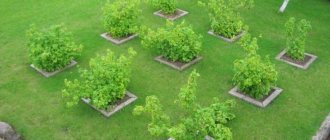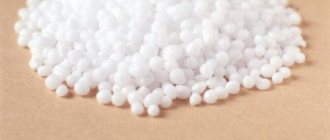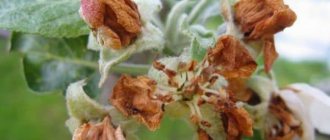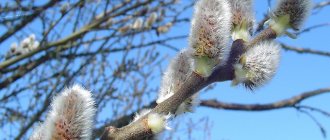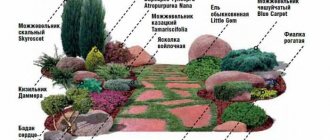Which trees turn red in autumn?
Before listing the trees whose leaves turn red in the fall, let's talk about why this happens.
You probably all know that the leaves are green at the beginning of their life cycle, the reason for which is such an important substance found in plants as chlorophyll.
The production of pigment responsible for photosynthesis is carried out by plants until the temperature conditions allow them to do so, that is, during the summer period. And then autumn comes and gradually begins to get colder.
In some regions, the color of the leaves begins to change already in mid-August, that is, the production process in the leaves begins to gradually stop from this period.
The content of red and yellow pigment in plants is constant, but due to the large amount of chlorophyll, it is difficult for it to “manifest”, and therefore the leaves are green. But when pigment is no longer produced for photosynthesis, the leaves gradually begin to change their color.
Now the trees turn red in some cases and yellow in others. Why is this happening?
According to biologists, the reason for this is a pigment called anthocyanin. Plants mainly produce it in the fall. In the summer, it can be said to be practically absent from the leaves.
Anthocyanins perform the function of protecting leaves from freezing in cold weather and overheating in hot weather. But besides this, it also repels parasites.
In some continents, in the autumn, trees and shrubs turn yellow (Europe may be included), and in others they turn red (America and Asia).
Which trees turn red in autumn?
Typically, trees such as mountain ash, maple, aspen and bird cherry turn red in the fall.
Tree leaves. Making a herbarium
The book “My Herbarium. Leaves of Trees" is a ready-made album for the herbarium. It contains 16 spreads dedicated to 16 trees, the most common in our area. These are birch, maple, chestnut, linden, rowan, poplar, aspen, oak, ash, elm, alder, willow, spruce, pine, larch, apple tree.
By the way, this is the special value of books written by domestic authors: everything here is about our realities. Any tree can be found near your home or in the nearest park.
Each spread of “My Herbarium” contains magnificent illustrations and many interesting details about how a tree works, why it is called that, what leaves, flowers and fruits it has, and what benefits people get from it.
For example, maple. What can you find out about him? For example, the fact that maple trees also have flowers! For many this will be unexpected news. The maple tree is also a symbol of Canada and a source of delicious maple sap from which syrup is made. And maple wood is valued for its clear and beautiful “voice”, which is why musical instruments are often made from it.
And this is an elm. A very common tree, which for some reason few people can recognize and identify right away. And it’s probably a shame for the elm, because it’s so beautiful! And don’t forget to stroke its leaves - they are very velvety on the inside. And – very recognizable! Take a closer look: you see that they are unequal - as if one half of the sheet decided to run away, moved a little, and then changed its mind.
And here is the rowan. Which of us, as a child, did not try its juicy red berries? We tried it and made a face: wow, that’s bitter! But they tried it wrong! It turns out that these berries become sweet after the first frost. I’m making a mental note: be sure to try rowan this winter!
There is a lot of space in the book for gluing leaves. And for good reason! If you collect, for example, leaves of different types of oak or maple, they will all fit on the desired page, and you won’t even have to crowd together.
All “herbarium” pages in the book are covered with tracing paper. This is very convenient for storing dried leaves. You insert the sheet, glue it if you wish, and that’s it, you’re done! Here, for example, is our birch page.
And at the bottom of each page, don’t forget to sign where and when you found this sheet. In the park or on the embankment, near the school or in the yard of your house. At the same time, you will capture the geography of your own walks for the future!
Which trees turn yellow in autumn? What color are the leaves in the autumn
Autumn is a bright period in nature, when the forest changes the color of its leaves from green to yellow, red and brown in a matter of days.
What explains the riot of colors during the leaf viewing season? Why do some trees turn yellow, others turn red, and then they turn brown.
The explanation lies in the replacement of chlorophyll with other substances: carotenoids and anthocyanins. In summer, trees have a lot of nutrients, but with the arrival of autumn, this supply gradually decreases. With the depletion of reserves, the synthesis of chlorophyll stops. And then other pigments that are present in the leaves, but overlapped by the green color - yellow and orange - become noticeable. These are the same pigments that determine, for example, the color of carrots - carotenoids.
Leaves with red hues are the result of the formation of anthocyanins. These pigments are absent in green leaves. They begin to form in the leaves of some plant species after the disappearance of chlorophyll. Anthocyanins are the same pigments that give radishes, geraniums, roses or cauliflower their color.
The brightness of the color of autumn leaves depends on the weather. Trees wear their most beautiful clothes in sunny, dry weather, at temperatures of 0 – 7 degrees Celsius. If the weather is cloudy and rainy, then the leaves do not burn, but turn into dull yellow shades or even turn brown.
As winter approaches, yellow and red leaves gradually lose their pigments. Brown leaves, which can be seen in late autumn, with the onset of severe cold, after snowfall, are leaves in which there are no pigments left at all, and the cell walls have become noticeable.
Decorative apple tree
Among the fruit trees, it is also worth remembering the decorative apple tree, which will undoubtedly decorate any area. In the spring, during the flowering period, it pleases with its soft lilac flowers, in the summer with the unexpected color of purple leaves, and in the fall with bright red fruits.
The advantage of ornamental apple trees is their unpretentiousness. You can care for them like regular apple trees. In addition, the trees are winter-hardy and drought-resistant. And at the same time they manage to remain decorative throughout the entire season.
The best varieties of ornamental apple trees: Weeping (or riverside), Nedzvetsky, Royalty, Royal Beauty, Pioneer.
Tree with red leaves in autumn. Trees with red leaves in landscape design
More and more ornamental trees and shrubs have purple and red leaves. They are usually brightest in the spring and darken and become less vibrant in the summer and fall. Some of them, such as peaches and some apple trees, turn red immediately after blooming and then turn completely green. Such bushes and crowns need to be trimmed, because their young shoots look just like flowers against the background of old ones.
Since red pigments increase resistance to the scorching sun and prevent attack by herbivorous insects, it is not surprising that the number of purple and red trees and shrubs used in landscaping is growing rapidly.
Many of them also have other attractive features: an interesting leaf shape, a weeping or spherical crown. Bladderwort, Japanese spirea, elderberry, barberry, cherry and apple trees also bloom and bear fruit beautifully.
For gardens, first of all, it is worth choosing those varieties that grow slowly. Small plants, such as Japanese dwarf spirea and Barberry thunberga 'Bagatelle', are often present in gardens in place of moderately tall perennials. They grow best in full sun - so you can use them as a protective umbrella for more sensitive plant species. They do not grow very well in the shade because they feel a lack of light.
In landscape design, it is better to use red leaf in moderation. The most effective compositions are plants with red leaves in a duet with green-violet or multi-colored trees, including golden or light green variations.
Barberry
Red-leaved barberry captivates with its beauty at first sight. Lighting the purple “fire” from early spring, it continues to delight with its decorative effect until late autumn. Thanks to its unpretentiousness and incredible decorativeness, this low shrub has gained a certain popularity and has long been a welcome guest in many gardens in the middle zone.
Thanks to its extraordinary decorative properties, barberry is good everywhere - as a hedge, in combination with conifers, in single plantings.
A striking representative of the family is the Thunberg barberry, which is especially valued for the color of its foliage. Among the decorative varieties are Golden Ring with a thin golden edging of dark red leaves and Rose Glow with original pinkish-brown leaves dotted with white “sprays”.
Which trees have yellow leaves in autumn? Which trees have yellow leaves in autumn?
The leaves of trees and other vegetation contain three main pigments: carotene, anthocyanin and the photosynthetic pigment chlorophyll, which absorbs energy from the sun and converts it into food for plants. It is chlorophyll, found in abundance in leaves, that provides foliage with its green color in spring and summer.
There is another substance in the leaves - the plant growth hormone auxin, which controls a special type of cells located at the base of the leaf cuttings - the so-called shedding layer. During growth, auxin prevents it from fully forming and blocks the tiny internal capillaries that connect each leaf to the tree's circulation system, reports https://www.sciencedaily.com/.
However, with the arrival of autumn, cooler and shorter days stop the production of auxin, which stimulates the growth of the shedding layer, and the circulation of water, nutrients and sugars in the leaves is blocked. When this happens, the rapid breakdown of chlorophyll begins, and the leaves turn yellow thanks to carotene. At the same time, anthocyanin provides their orange and reddish shades. In cloudy weather, anthocyanin activity decreases and orange or yellow leaves are more common, but not red foliage.
A group of scientists from the University of North Carolina at Charlotte have found new patterns in the appearance of red and yellow leaves in the fall. The research was led by Emily Habink, who examined different tree species in different areas.
It turned out that red leaves usually appear on trees that grow in poor soil, and yellow leaves on trees that grow in rich soil. It was also found that red leaves make it possible to more efficiently use the nutrients they contain in conditions of their deficiency.
As you know, in the fall the synthesis of the green pigment chlorophyll, necessary for photosynthesis, stops in the leaves. After which the leaves change color and fall off, but before that the tree extracts all the nutrients from them and stores them for the winter. And this is especially important for trees growing in poor soil.
There is an opinion among scientists that the red color of the leaves is given by the anthocyanin pigment, which usually begins to be synthesized just in the fall, when chlorophyll breaks down. However, then it is not clear why trees should waste energy on the synthesis of new pigment in leaves that will soon fall anyway. However, one theory is that the new pigment protects weakened and vulnerable leaves from sunlight, allowing them to last as long as possible so that the tree can extract as many nutrients from them as possible.
Adhering to this theory, Habink tried to confirm or refute it. Through research on red maple and amberwood, she discovered that in higher elevations where the soil is poorer, these trees have much redder leaves than the same species in fertile floodplain areas. Therefore, the findings support the theory that the production of anthocyanins helps the leaves last as long as possible and allows the tree to more efficiently stock up on nutrients for the winter.
Varieties of trees. Deciduous trees and shrubs: names and photos
Deciduous trees and shrubs include many varieties. Next you can see photos of deciduous trees, which are often found in gardens in central Russia. We suggest you find out the names of deciduous trees, which can be fruit-bearing and decorative.
HORSE CHESTNUT – AESCULUS
- Flowering time: depends on the species
- Location: best sunny
- Reproduction: acquiring new plants
The common horse chestnut is too large for most gardens. Choose one of the bushy horse chestnuts instead. There is the small-flowered horse chestnut (A. parviflora) 3 m high, blooming with white flowers in July - August, and the pavia horse chestnut (A. pavia) of a similar size, blooming red candle inflorescences in July.
BIRCH – BETULA
- Flowering time: March - April
- Location: sunny or partial shade
- Reproduction: acquiring new plants
A popular tree with bark, most often white in color. Birch trees have a shallow root system - do not plant anything under them. Water during prolonged drought. Weeping Birch (B. pendula) 9 m high is popular - yellowish catkins, white bark, twisting branches. Its form 'Purpurea' has purple leaves and branches.
IRGA – AMELANCHIER
- Flowering time: April - May
- Location: sunny or partial shade
- Reproduction: by rooted offspring in autumn
Copper-red foliage and white flowers in spring, red berries in summer and orange-red leaves in fall. The most popular species is the Canadian Irga (A. canadensis) reaches a height of 6 m. Its star-shaped flowers appear in erect inflorescences, and its berries become black when ripe.
POPLAR – POPULUS
- Location: sunny or partial shade
- Reproduction: acquiring new plants
This tree is not for small gardens. The leaves of T. white or silver (Palba) 10 m high have pubescence on the underside, and the leaves of large-leaved poplar (P candicans) 'Aurea' are variegated. Pyramidal Black Poplar (P nigra) 'Italica' is one of the best trees with a narrow columnar crown shape.
CARYOPTERIS
- Flowering time: September - October
- Location: must be sunny
- Reproduction: by cuttings under glass in summer, woody cuttings in autumn
A rounded border shrub that grows in all types of soils, including chalk. The main species is C. clandonensis, 1 m high. It has gray-green leaves and lavender flowers in terminal inflorescences 10 cm long. The variety 'Kew Blue' has dark blue flowers.
Skumpia
Among the red shrubs, special attention should be paid to the leather mackerel. An adult plant may look like an elegant tree with a branched crown in the shape of a ball or umbrella. The unusual foliage gives the mackerel a special charm: bluish-green leaves on long petioles become fiery red in autumn, which then changes to red or burgundy.
If you rub mackerel leaves in your hands, you can smell the carrots.
Mackerel is no less interesting during flowering, which occurs in the second half of summer. From afar, branching paniculate inflorescences look like clouds enveloping a bush. When the light flowers fall off, orange-pink pedicels remain. Because of them, the plant received its second name: wig tree (these threads are very similar to thick hair).
The plant is unpretentious, grows well in the garden and feels good even on rocky soil. But it also has a significant drawback: the plant is not very winter-hardy.
Trees in autumn description. Sunday walk in the forest in autumn (essay)
Autumn is a wonderful and very surprising time of year! There are trees around with yellowed and half-fallen leaves, and under your feet lies a huge carpet, full of a crazy variety of all bright and rich shades. And it’s even better if such wonderful landscapes are accompanied by the autumn sun, which no longer burns like in summer, but only slightly caresses and warms.
In such weather it would be unforgivable to sit at home; the best thing to do would be to take a walk. And the best day for a walk will be Sunday. A day off when you don’t need to rush or rush anywhere, but can take a measured and sedate walk through the autumn forest.
Such a walk evokes romantic images and is suitable for both a child and an old man. It would be best to take a walk alone to think about life, reflect on your worldview and admire the beauty of nature falling asleep for the winter. It’s still warm, there’s no cold or frost, but a slight chill has already forced people to put on jackets and scarves. The walk will be very captivating and will be remembered for a long time. The sky may not be overcast, but delight with its blueness and small clouds. Migratory birds are already flying south in their schools.
What deep thoughts about life are evoked by autumn nature, painted in different colors. There are so many divine shades here! There is yellow, and orange, and red, and even remnants of green. And all this abundance of flowers, a riot of colors surrounds us on all sides. It is these cozy walks in silence and solitude that will help you relieve stress, focus on something important to yourself, take a break from the bustle of the big city and retire to yourself.
Sunday walks in the forest, of course, can be carried out at any other time of the year, but autumn gives them a special charm and splendor, because autumn is the sunset of nature, which follows its long winter sleep.
red leaf plum
The red-leaved plum is also unusually beautiful, the crown of which is painted in bright red-brown shades, and the flowers are pale pink. In summer, red fruits appear, which look no less decorative on the branches.
The red-leaved plum looks advantageous against the backdrop of evergreen conifers and along paths. The tree lends itself well to shaping, so it can be grown in group plantings to create a hedge, giving the crowns a compact spherical shape.
The Cistena variety with a columnar crown and red-violet foliage, as well as Rannyaya with a rounded crown dotted with brown-red leaves, are particularly decorative.

